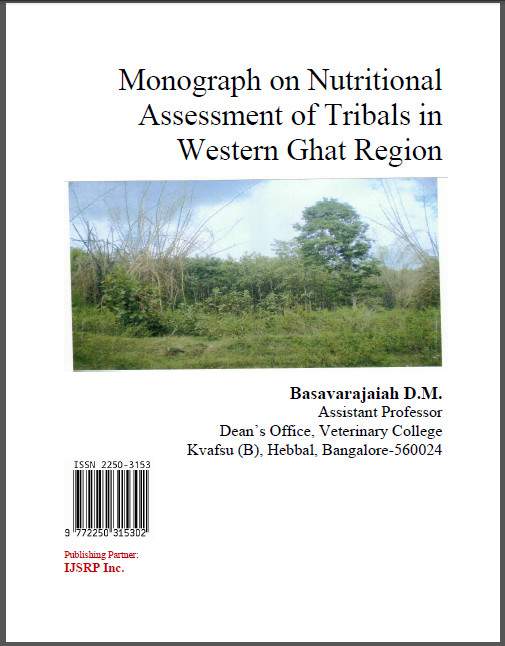
Title:
Monograph on Nutritional Assessment of Tribals in Western Ghat Region
Authors:
Basavarajaiah D.M.
PREFACE
As per the Ministry of tribal welfare, the article 366 (25) of the Constitution of India refers to Scheduled tribes as those communities, who are scheduled in accordance with article 342 of the Constitution. This article says that only those communities who have been declared as such by the president through an initial public notification or through a subsequent amending act of parliament will be considered to be scheduled tribes. We got independence of India since 68 years, till date the peoples have been accrued to living with poverty, indebtedness, poor health care, loss of production assets and governance failure.
However, the preceding of actual facts and figures of Chronic Poverty Research Centre (CPRC) envisaged that, an about eight percent of India's population, they account for a fourth of population living in poorest wealth decile.The starkest marker of tribal deprivation is child mortality, lack of food, shelter and pitfall of basic amenities for daily routine life; undoubtedly the quality life of tribals were seen worsen. The tribal deprivation is alarming stage due to the lower human health index, higher mortality, starvation etc. Under -five mortality rates among tribal children in forested areas remain startlingly high. Unlike other excluded groups in India, such as Scheduled castes. Tribal groups do not face any ritually endorsed exclusion say, in the form of untochability. Poverty is becoming hereditary in India, at least for a sizeable population. That is the conclusion derived from a three-decade tracking of poor households in tribal population. Although tribal population living in forested areas is at a higher risk of under nutrition because of their dependence on primitive collection of NTFP's , agricultural labour works, elevated poverty and irregularity of food supply. Similarly, health is prerequisite for human development and is an essential component for well being of the mankind. The health problems of any communities influence by interplay of various factors including social, economic, biological and political ones. Nutritional status of population is an important tool to know the status of health index of any population .Although it will be depends on the consumption of food in relation to the need and requirements.
It is well accepted that a good nutrition level grounding is more essential for the development of Quality life of people living (QOL) in forested areas without basic amenities. This monograph is serving as tool for implementation of new innovative developmental programme at national level in tribal areas.
Throughout the monograph there is generous criticism on nutritional level, demographic quality of life-domains and tribal traditional knowledge of medicinal plants with respect to curing of chronic illness and disorder. The overall salient findings are discussed with suitable statistical analysis. Finally, I sincerely hope that policy makers, researchers and academician read the research work which set the ethos and philosophy.
To read further you can click on Download link.
|

|

